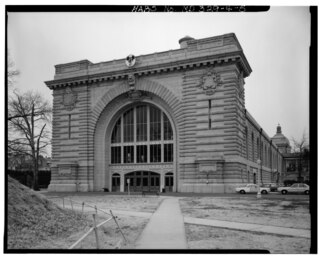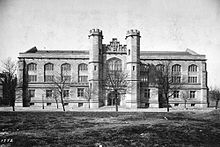
The Big Ten Conference is the oldest Division I collegiate athletic conference in the United States. Founded as the Intercollegiate Conference of Faculty Representatives in 1896, it predates the founding of its regulating organization, the NCAA. It is based in the Chicago area in Rosemont, Illinois. For many decades the conference consisted of 10 prominent universities, which accounts for its name. As of 2014, it consists of 14 member institutions and 2 affiliate institutions, with 4 new member institutions scheduled to join in 2024. The conference competes in the NCAA Division I and its football teams compete in the Football Bowl Subdivision (FBS), formerly known as Division I-A, the highest level of NCAA competition in that sport.

The Illinois Fighting Illini are the intercollegiate athletic teams that represent the University of Illinois Urbana-Champaign. The university offers 10 men's and 11 women's varsity sports.

The Memorial Athletic and Convocation Center, often referred to as the MAC Center and the MACC, is a multi-purpose arena on the campus of Kent State University in Kent, Ohio, United States. The building is primarily used as an athletic venue that is home to five Kent State Golden Flashes varsity athletic teams: men's basketball, women's basketball, women's volleyball, women's gymnastics, and wrestling. In addition, it hosts commencement exercises, speakers, and concerts throughout the year. The building houses the offices of the Kent State Athletic Department and the coaches of each of the university's varsity athletic teams.

The Penn State Nittany Lions are the athletic teams of Pennsylvania State University, except for the women's basketball team, known as the Lady Lions. The school colors are navy blue and white. The school mascot is the Nittany Lion. The intercollegiate athletics logo was commissioned in 1983.

Newton C. Loken was an artistic gymnast and coach of gymnastics, trampolining and cheerleading. While a member of the Minnesota Golden Gophers men's gymnastics team, Loken was NCAA all-around gymnastics champion in 1942 and the Big Ten Conference all-around champion in 1941 and 1942. He was the coach of the University of Michigan gymnastics team for 36 years from 1948-1983. Loken's gymnasts won the NCAA championships in 1963 and 1970, as well as 12 Big Ten championships. His record as Michigan's gymnastics coach was 250-72-1. Loken also coached the Michigan trampolining team to NCAA championships in 1969 and 1970.

The NCAA Men's Gymnastics Championships are a gymnastics competition held each year to determine the best men's college gymnastics team. All schools compete in one National Collegiate division because only 15 schools sponsor NCAA men's gymnastics teams. Three of the 15 teams are not in Division I: Greenville University, Simpson College, Springfield College.

The NCAA women's gymnastics tournament is an annual gymnastics competition to determine the best collegiate women's gymnastics team in the country. Unlike most NCAA sports, the women's gymnastics championship is not separated into divisions and uses a single National Collegiate tournament instead.
Trinity Lemyra Thomas is an American artistic gymnast and a four-time National Team member (2016–20). She was a member of the gold medal-winning team at the 2018 Pan American Gymnastics Championships, where she also won silver medals in the individual all-around and on the uneven bars, as well as the bronze medalist on balance beam and floor exercise at the 2017 national championships. She was a member of the Florida Gators women's gymnastics team. One of the most successful NCAA gymnasts in history, Thomas finished her collegiate career with a record-tying 28 perfect-10 scores and a record-breaking five Gym Slams.

The 1938 NCAA gymnastics championships were contested at the first annual National Collegiate Athletic Association-sanctioned men's gymnastics championships to determine the team and individual national champions of men's collegiate gymnastics among its member programs in the United States.
William Henry Roetzheim, Jr. was an American gymnast, collegiate coach, and administrator. He competed at the 1948 Summer Olympics and the 1952 Summer Olympics. Roetzheim won gold at the 1951 Pan American Games, and he was also an army veteran who served in the Korean War.
Marshall Scott Avener is an American gymnast. He competed at the 1972 Summer Olympics and the 1976 Summer Olympics.
The 2022 NCAA Men's Gymnastics Championships was held from April 15–16, 2022 at the Lloyd Noble Center in Norman, Oklahoma.

The 1939 NCAA gymnastics championships were contested at the second annual National Collegiate Athletic Association-sanctioned men's gymnastics championships to determine the team and individual national champions of men's collegiate gymnastics among its member programs in the United States.

The 1940 NCAA gymnastics championships were contested at the third annual National Collegiate Athletic Association-sanctioned men's gymnastics championships to determine the team and individual national champions of men's collegiate gymnastics among its member programs in the United States.

The 1941 NCAA gymnastics championships were contested at the fourth annual National Collegiate Athletic Association-sanctioned men's gymnastics championships to determine the team and individual national champions of men's collegiate gymnastics among its member programs in the United States.

The 1942 NCAA gymnastics championships were contested at the fifth annual National Collegiate Athletic Association-sanctioned men's gymnastics championships to determine the team and individual national champions of men's collegiate gymnastics among its member programs in the United States.

The 1949 NCAA gymnastics championships were contested at the seventh annual National Collegiate Athletic Association-sanctioned men's gymnastics championships to determine the team and individual national champions of men's collegiate gymnastics among its member programs in the United States.
The 1953 NCAA gymnastics championships were contested at the 11th annual NCAA-sanctioned gymnastics meet to determine the team and individual national champions of men's collegiate gymnastics among its member programs in the United States.










